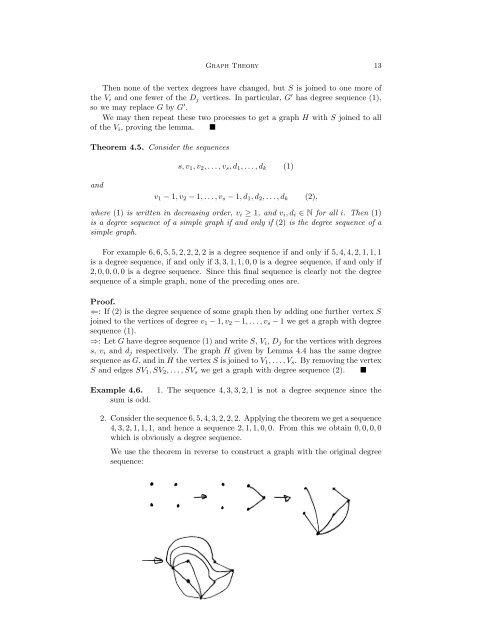Create successful ePaper yourself
Turn your PDF publications into a flip-book with our unique Google optimized e-Paper software.
<strong>Graph</strong> <strong>Theory</strong> 13Then none of the vertex degrees have changed, but S is joined to one more ofthe V i and one fewer of the D j vertices. In particular, G ′ has degree sequence (1),so we may replace G by G ′ .We may then repeat these two processes to get a graph H with S joined to allof the V i , proving the lemma. Theorem 4.5. Consider the sequencess, v 1 , v 2 , . . . , v s , d 1 , . . . , d k (1)andv 1 − 1, v 2 − 1, . . . , v s − 1, d 1 , d 2 , . . . , d k (2),where (1) is written in decreasing order, v i ≥ 1, and v i , d i ∈ N for all i. Then (1)is a degree sequence of a simple graph if and only if (2) is the degree sequence of asimple graph.For example 6, 6, 5, 5, 2, 2, 2, 2 is a degree sequence if and only if 5, 4, 4, 2, 1, 1, 1is a degree sequence, if and only if 3, 3, 1, 1, 0, 0 is a degree sequence, if and only if2, 0, 0, 0, 0 is a degree sequence. Since this final sequence is clearly not the degreesequence of a simple graph, none of the preceding ones are.Proof.⇐: If (2) is the degree sequence of some graph then by adding one further vertex Sjoined to the vertices of degree v 1 − 1, v 2 − 1, . . . , v s − 1 we get a graph with degreesequence (1).⇒: Let G have degree sequence (1) and write S, V i , D j for the vertices with degreess, v i and d j respectively. The graph H given by Lemma 4.4 has the same degreesequence as G, and in H the vertex S is joined to V 1 , . . . , V s . By removing the vertexS and edges SV 1 , SV 2 , . . . , SV s we get a graph with degree sequence (2). Example 4.6.sum is odd.1. The sequence 4, 3, 3, 2, 1 is not a degree sequence since the2. Consider the sequence 6, 5, 4, 3, 2, 2, 2. Applying the theorem we get a sequence4, 3, 2, 1, 1, 1, and hence a sequence 2, 1, 1, 0, 0. From this we obtain 0, 0, 0, 0which is obviously a degree sequence.We use the theorem in reverse to construct a graph with the original degreesequence:













